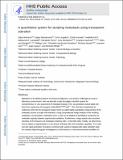A Quantitative System for Studying Metastasis Using Transparent Zebrafish
Author(s)
Heilmann, S.; Ratnakumar, K.; Langdon, E. M.; Kansler, E. R.; Kim, I. S.; Campbell, N. R.; Perry, E. B.; Kaufman, C. K.; van Rooijen, E.; Lee, W.; Iacobuzio-Donahue, C. A.; Zon, L. I.; Xavier, J. B.; White, R. M.; Hynes, Richard O.; McMahon, Amy J.; ... Show more Show less
DownloadHynes_A quantitative system.pdf (1.051Mb)
OPEN_ACCESS_POLICY
Open Access Policy
Creative Commons Attribution-Noncommercial-Share Alike
Terms of use
Metadata
Show full item recordAbstract
Metastasis is the defining feature of advanced malignancy, yet remains challenging to study in laboratory environments. Here, we describe a high-throughput zebrafish system for comprehensive, in vivo assessment of metastatic biology. First, we generated several stable cell lines from melanomas of transgenic mitfa-BRAF[superscript V600E];p53[superscript −/−] fish. We then transplanted the melanoma cells into the transparent casper strain to enable highly quantitative measurement of the metastatic process at single-cell resolution. Using computational image analysis of the resulting metastases, we generated a metastasis score, μ, that can be applied to quantitative comparison of metastatic capacity between experimental conditions. Furthermore, image analysis also provided estimates of the frequency of metastasis-initiating cells (∼1/120,000 cells). Finally, we determined that the degree of pigmentation is a key feature defining cells with metastatic capability. The small size and rapid generation of progeny combined with superior imaging tools make zebrafish ideal for unbiased high-throughput investigations of cell-intrinsic or microenvironmental modifiers of metastasis. The approaches described here are readily applicable to other tumor types and thus serve to complement studies also employing murine and human cell culture systems.
Date issued
2015-08Department
Massachusetts Institute of Technology. Department of Biology; Koch Institute for Integrative Cancer Research at MITJournal
Cancer Research
Publisher
American Association for Cancer Research
Citation
Heilmann, S. et al. “A Quantitative System for Studying Metastasis Using Transparent Zebrafish.” Cancer Research 75.20 (2015): 4272–4282.
Version: Author's final manuscript
ISSN
0008-5472
1538-7445